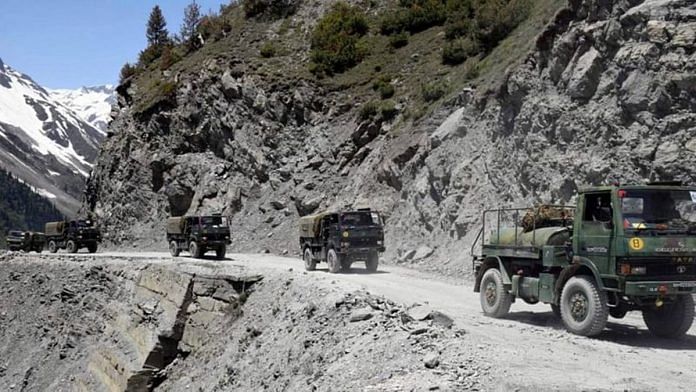New Delhi: The 14th round of India-China military commander level talks begin Wednesday in eastern Ladakh, amid indications that Beijing is seeking to cement the current status quo, while New Delhi hopes for disengagement at the Hot Springs area, and eventual de-escalation.
Top government sources told ThePrint that tensions between India and China will continue irrespective of whether Wednesday’s talks move forward. This is based on the understanding that while disengagement at Hot Springs — which was first agreed upon in July 2020 — may finally happen, “legacy issues” like Depsang Plains and Demchok will take much longer.
The sources also said that given the scale of build-up in infrastructure on both sides of the Line of Actual Control (LAC), practically, it is going to be “tough” to expect any side to go back to April 2020 status — what was being sought initially.
The sources, while underlining that the Chinese’ words cannot be trusted, expressed satisfaction over disengagement at four of the five stand-off points in eastern Ladakh since May 2020 — Galwan Valley, northern bank of Pangong Tso, Kailash Range and Gogra — over the past 18 months.
“It is significant that the Chinese have pulled back from areas where they had come in and built infrastructure. The Chinese have never done so anywhere else,” a top-ranking source said.
The Wednesday talks are set to focus on disengagement from Hot Springs and not the flareup of tensions in the Depsang Plains and Demchok, termed “legacy issues”, which were points of contention during the 13th round of talks held in October last year.
The 13th round of talks had ended in failure, with the Indian side standing firm and stating that the situation along the LAC had been caused by unilateral attempts by the Chinese side to alter the status quo.
The Indian Army had, in a statement, said: “During the meeting, the Indian side therefore made constructive suggestions for resolving the remaining areas, but the Chinese side was not agreeable and also could not provide any forward-looking proposals. The meeting thus did not result in resolution of the remaining areas.”
Also Read: India against third-party mediation in talks with China, military on alert ‘for any eventuality’
China’s indications of seeking to cement status quo
While confirming the dates for the 14th round of talks, Chinese foreign ministry spokesperson Wang Wenbin said Tuesday that the situation in the border areas is stable on the whole.
However, Wang added, “We hope India will work to help the situation to move from emergency handling to a regular daily-based management phase”.
This public statement emphasising “daily-based management phase” has raised eyebrows in sections of the defence establishment, as it seems to imply that China is seeking to suggest that the current holding positions are the new status quo.
This was in line with what the Chinese had been saying prior to the 13th round of military talks.
In September last year, Chinese State Councillor and Foreign Minister Wang Yi had told External Affairs Minister S. Jaishankar that India and China should engage and focus on the “normalised management” of the disputed border, rather than just resort to “emergency response”.
“One will have to wait and see how the talks progress. The Indian stand is very clear that there needs to be a disengagement first at all friction points that came up since May 2020, and then eventual de-escalation, which means that things go back to what they were in April 2020,” a source said.
Currently, while both Indian and Chinese troops have disengaged from Galwan Valley, the Kailash Range, finger area in northern banks of Pangong Tso and Gogra, buffer zones have been created.
This means that neither side will patrol areas that they earlier patrolled, amid a feeling in some sections of the military fraternity that it is more inimical to India’s interest.
According to the terms agreed upon in July 2020, even if any limited patrol is to be undertaken for verification process, either side has to inform the other first.
Sources said the understanding was that once disengagement is completed at all friction points, restoration of patrolling rights would be taken up in due course.
(Edited by Gitanjali Das)
Also Read: In 2022, India-China glass is both half-full and half-empty. Russia can be tipping factor






